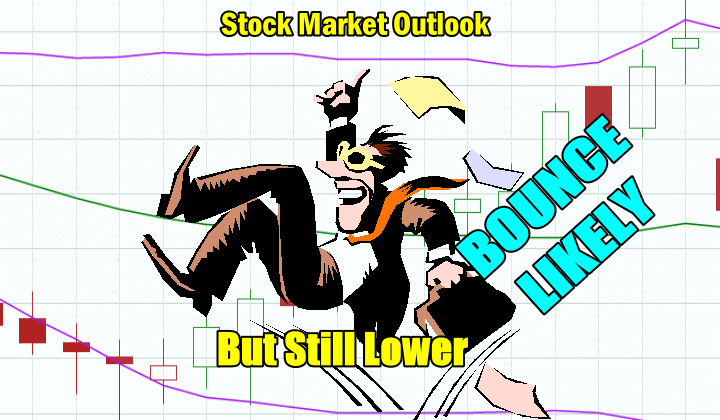
What Happened On Tue Jan 30 2018
With healthcare stocks in decline and concerns over rising bond yields and the probability of higher interest rates by March, investors took profits for a second day. The Dow lost 1.37%, the S&P 1.09% and the NASDAQ 0.86%.
Closing Statistics for Tue Jan 30 2018
S&P 500 Index Close
The S&P index ended down 31.10 to 2822.43
Dow Jones Index Close
The Dow Jones ended down 362.59 to 26,076.89
NASDAQ Index Close
The NASDAQ closed down 64.02 to 7402.48
Stock Market Outlook – Review of Tue Jan 30 2018
Chart Comments At The Close:
The drop on Tuesday left the S&P below the Upper Bollinger Band for a second day and nearing the 21 day moving average. The Lower Bollinger Band is continuing to rise and the Upper Bollinger Band is flattening out. We may see a Bollinger Bands Squeeze develop late this week or into next week. All the major moving averages are rising but the 100 and 200 day are starting to turn sideways.

Stock Market Outlook review of Tue Jan 30 2018
Stock Market Outlook: Technical Indicators:
All the signals turned lower and lost more strength on Tuesday.
Momentum: For momentum I use a 10 period when studying market direction. Momentum is positive and falling.
MACD Histogram: For MACD Histogram, I am using the Fast Points set at 13, Slow Points at 26 and Smoothing at 9. MACD (Moving Averages Convergence / Divergence) issued a buy signal on Jan 4. That buy signal turned very weak on Tuesday.
Ultimate Oscillator: The Ultimate Oscillator settings are: Period 1 is 5, Period 2 is 10, Period 3 is 15, Factor 1 is 4, Factor 2 is 2 and Factor 3 is 1. These are not the default settings but are the settings I use with the S&P 500 chart set for 1 to 3 months. The Ultimate Oscillator signal is positive but has fallen close to turning negative.
Slow Stochastic: For the Slow Stochastic I use the K period of 14 and D period of 3. The Slow Stochastic tries to predict the market direction further out than just one day. The Slow Stochastic is overbought and has a down signal in place.
Relative Strength Index: The relative strength index is set for a period of 5 which gives it 5 days of market movement to monitor. It often is the first indicator to show an overbought or oversold signal. The RSI signal is moving sharply lower.
Rate of Change: Rate Of Change is set for a 21 period. This indicator looks back 21 days and compares price action from the past to the present. The rate of change signal is positive and and turned lower.
Support Levels To Be Aware Of:
2675 and 2620 are light support.
There is good support at the 2550 level.
The S&P has light support at 2480. It also has light support at 2450 and good support at 2425. Below that there is some support at 2400, 2380, 2350. 2300 has the most support at present but would represent a full correction as a drop to this level would be almost 15%.
Stock Market Outlook for Tomorrow – Wed Jan 31 2018
Selling on Tuesday increased and the drop was stronger but with that drop the S&P looks set to try a short rebound on Wednesday before probably heading to the 21 day moving average where it can stage a stronger rebound attempt. So what we should anticipate is a bounce attempt being likely and then more selling. The S&P may not fall to the 21 day on Tuesday but could on Wednesday. The bounce on Tuesday will be highly suspect. A bounce off the 21 day moving average later this week would be stronger.
Market Direction Internal Links
Profiting From Understanding Market Direction (Articles Index)
Understanding Short-Term Signals
Market Direction Portfolio Trades (Members)
Market Direction External Links
IWM ETF Russell 2000 Fund Info
Market Direction SPY ETF 500 Fund Info
